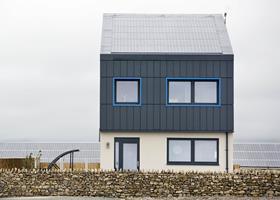The research centre behind the Solcer House ÔÇśsmart homeÔÇÖ slams government U-turn on zero carbon

The creator of the UKÔÇÖs first ÔÇśpower station houseÔÇÖ - the Solcer House in south Wales, which generates almost three times more energy than it needs - has slammed the governmentÔÇÖs U-turn on zero carbon homes.
Keith Bygate, head of the Specific research centre that came up with the concept behind the Solcer House, told ║┌Â┤╔šă° the cutting-edge scheme demonstrated zero carbon buildings were ÔÇťcommercially viableÔÇŁ.
Solcer House (pictured) was conceived by Specific, a research centre based out of Swansea University, and designed by the Welsh School of Architecture at Cardiff University. The scheme attracted widespread national media coverage last week.
Over the course of a year, the zero carbon ÔÇśsmart homeÔÇÖ generates ┬ú175 in energy exported to the national grid for every ┬ú100 spent on its own electricity use.
Solcer House collects and stores thermal and electrical energy, has an in-built photo voltaic roof system, LED lighting, low-carbon cement, high levels of insulation, hot water storage and high-tech wall panels that store external heat from the air.
The three-bedroom house cost around £120,000 to build, or around £1,000 per sqm, excluding the land price.
Bygate said that Solcer House ÔÇťshifts the gameÔÇŁ after the governmentÔÇÖs decision to scrap its zero carbon targets and slammed the governmentÔÇÖs reasoning that zero carbon homes were too expensive.
He said: ÔÇťThe government said it was going to be a financial burden, but this house shifts the game as weÔÇÖve shown it is a cost-effective way to provide clean and secure energy.ÔÇŁ
He added: ÔÇťAll of the components are commercially available so there are no real skill barriers to making these houses. The whole point of it was to build something that can be replicated.ÔÇŁ
Prototype energy positive homes are starting to become more common. Architect Jeremy Harrall has designed and delivered a power generating home in Lincolnshire, dubbed Frankly Bee.
The naturally heated and ventilated home generates 32% more energy than it consumes.



























2 Readers' comments